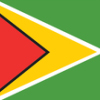INTELLECTUAL PROPERTY RIGHTS IN GUYANA

Opposition Term |
01 Month |
Registration Term |
07 Years |
First Renewal Term |
14 Years |
Subsequent Renewal Term |
14 Years |
The Trade Marks Act, Cap 90:01, in force since 1952 - is the primary law governing the mechanism of trademark registration and protection in Guyana.
Guyana is not a member of the Madrid Agreement and the Madrid Protocol.
For getting a trademark registered in Guyana, an application has to be filed with the Deeds Registry, which administers the entire trademark registration process.
Any mark deemed registrable by the UK IPO would be deemed registrable by the local registry in Guyana if applying based on that UK mark.
The 11th edition of the Nice Classification applies to UK-based applications and covers goods and services in classes 1-45. For local applications, International classes 1-34 apply as provided in the Trade Mark Rules and may be used to register goods only.
Multi-class applications are possible if the application is based on a prior UK registration. However, for applications within the local system, a separate application must be filed for each class.
The third parties can file opposition actions against a trademark application within one (01) month from its publication date.
In Guyana, locally registered trademarks have a validity of seven (07) years from the date of application, which can be further renewed indefinitely for successive periods of fourteen (14) years each. On the other hand, any mark that is registered based upon an existing UK registration has a term that is identical to that of the corresponding UK registration.
The grace period to renew a trademark after the date of expiry is one (01) month with a penalty.
The term for cancellation of a registered trademark based on non-use is five (05) years from the date of registration.
Guyana is a member of the Paris Convention for the Protection of Industrial Property.
The Guyana Patents and Designs Act deals with the mechanism of patent protection in the country.
The Act also provides for the registration of United Kingdom patents in Guyana.
In Guyana, the "true and first inventor" of a product may apply to the Registrar of Deeds for a patent. Accompanying the application must be a description of the nature of the invention. The Registrar may also require a detailed description and drawing of the invention.
In Guyana, an opposition against a patent application can be raised at the pre-grant stage within two (02) months approximately following its publication.
The patent of invention lasts for sixteen (16) years in Guyana. A patentee may request an extension of five (05) or ten (10) years within six (06) months before the expiry of the term.
The Guyana Patents and Designs Act - governs and deals with the mechanism of registration of industrial designs in Guyana.
The Act also provides for the registration of United Kingdom industrial designs in Guyana.
The process of industrial design registration in Guyana includes filing of the application, formal and substantial examination, publication in the official journal, a period for filing of oppositions, and grant or denial of the industrial design application.
The total duration of industrial design registration in Guyana is fifteen (15) years from the date of application. The initial registration term is five (05) years, which is further extendible for two (02) terms of five (05) years each upon payment of the renewal fee.
Guyana is a signatory to the Berne Convention for the Protection of Literary and Artistic Works and the TRIPS Agreement.
The Copyright Act 1956 (as modified by order of 1966) is the basic legislation governing copyright protection in Guyana.
The standard copyright protection term lasts for the lifetime of the author plus fifty (50) years following his death. However, the duration of copyright protection varies depending on the type of work.
Copyright in artistic works subsists until the end of the period of fifty (50) years from the end of the calendar year in which the author died.
Copyright in a cinematograph film shall continue to subsist until the film is published, and thereafter, until the end of the period of fifty (50) years from the end of the calendar year, which includes the date of its first publication.

